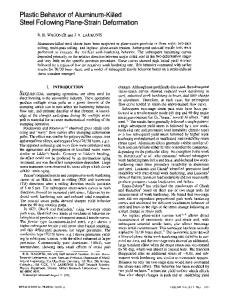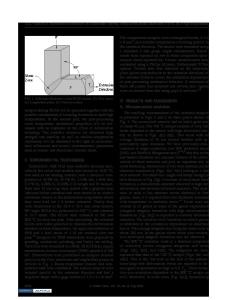The Microstructure Evolution of Dual-Phase Pipeline Steel with Plastic Deformation at Different Strain Rates
- PDF / 2,131,626 Bytes
- 8 Pages / 593.972 x 792 pts Page_size
- 63 Downloads / 382 Views
ÓASM International 1059-9495/$19.00
The Microstructure Evolution of Dual-Phase Pipeline Steel with Plastic Deformation at Different Strain Rates L.K. Ji, T. Xu, J.M. Zhang, H.T. Wang, M.X. Tong, R.H. Zhu, and G.S. Zhou (Submitted October 11, 2016; in revised form March 10, 2017; published online May 25, 2017) Tensile properties of the high-deformability dual-phase ferrite-bainite X70 pipeline steel have been investigated at room temperature under the strain rates of 2.5 3 1025, 1.25 3 1024, 2.5 3 1023, and 1.25 3 1022 s21. The microstructures at different amount of plastic deformation were examined by using scanning and transmission electron microscopy. Generally, the ductility of typical body-centered cubic steels is reduced when its stain rate increases. However, we observed a different ductility dependence on strain rates in the dual-phase X70 pipeline steel. The uniform elongation (UEL%) and elongation to fracture (EL%) at the strain rate of 2.5 3 1023 s21 increase about 54 and 74%, respectively, compared to those at 2.5 3 1025 s21. The UEL% and EL% reach to their maximum at the strain rate of 2.5 3 1023 s21. This phenomenon was explained by the observed grain structures and dislocation configurations. Whether or not the ductility can be enhanced with increasing strain rates depends on the competition between the homogenization of plastic deformation among the microconstituents (ultra-fine ferrite grains, relatively coarse ferrite grains as well as bainite) and the progress of cracks formed as a consequence of localized inconsistent plastic deformation. Keywords
high deformability, dual-phase pipeline steel, microstructure, plastic deformation, uniform elongation, strain rate
1. Introduction Currently there is a growing demand for higher grade pipeline steels in petroleum industry. Increasing the strength of the steels enables a significant reduction in the pipe wall thickness or the pipe to transport crude oil and gas at a higher operating pressure (Ref 1). At the same time, the ductility and toughness of the steels have to be kept high enough to prevent the pipe from local buckling and girth weld fracture, especially in harsh environment such as seismic regions where ground movements can be expected to impose large and fast strains. Therefore, high strength, high toughness and formability are important requirements of the pipeline steels (Ref 1). Recently, new design methodology, so-called strain-based design, for the pipeline engineering for seismic and permafrost region has been developed (Ref 2). According to the new concept, higher
L.K. Ji and J.M. Zhang, and Tubular Goods Research Institute of CNPC, XiÕan 710077 Shaanxi, China; and State Key Laboratory of Performance and Structural Safety for Petroleum Tubular Goods and Equipment Materials, XiÕan 710077 Shaanxi, China; T. Xu, M.X. Tong, R.H. Zhu, and G.S. Zhou, State Key Laboratory for Mechanical Behavior of Materials, XiÕan Jiaotong University, XiÕan 710049 Shaanxi, China; and School of Materials Science and Engineering, XiÕan Jiaotong University, XiÕan
Data Loading...










